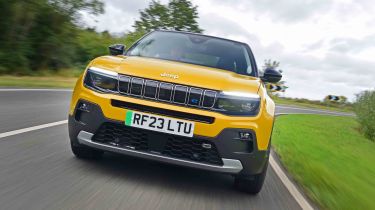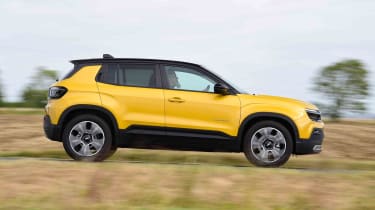Jeep Avenger - Engines, performance and drive
Previous Jeeps have often compromised on-road manners for their ability off-road, but not the Avenger

In keeping with the brand’s off-road heritage, the Jeep Avenger rides higher than some of its closest rivals and offers generous ground clearance to clamber over obstacles. There’s good all-round visibility thanks to the raised ride height, and a squared-off bonnet makes it easy to place the car on the road.
The vast majority of the petrol, hybrid and electric range is front-wheel drive, but there will be a four-wheel drive version called the 4xe, which is quite rare for the small SUV class, with only a tight-knit group of rivals such as the Lexus LBX and Toyota Yaris Cross offering the benefits of four-wheel drive traction for slippery conditions.
In addition to the usual Eco, Normal and Sport drive modes, there are Mud, Sand and Snow settings, and a hill descent system. Our experiences have been limited to lightly rutted dusty tracks, but we’d wager the Avenger could show its SUV rivals a clean pair of heels over wet or slippery terrain - especially in 4xe form.
| Model | Power | 0-62mph | Top speed |
| Avenger 1.2 GSE 100 manual | 99bhp | 10.6 seconds | 114mph |
| Avenger 1.2 e-Hybrid 136 4xe DCT6 auto | 134bhp | 9.5 seconds | 121mph |
| Avenger Electric 156 auto | 154bhp | 9.6 seconds | 93mph |
What is the Jeep Avenger like to drive?
In town
The Avenger does a good job of dealing with harsh potholes at low speeds, because the suspension soaks them up without too much crash into the cabin. We feel that the steering could do with a bit more weight and feel, but the upside of the light setup is it makes the car super-easy to drive around town.
Although the least powerful petrol doesn’t look to offer the sort of shove off the line required to mix it with city traffic, but in reality, it has a generous hit of low-down torque, so you can make it into gaps in the traffic without too much trouble. It could use a slicker six-speed gearbox, though, which isn’t as pleasant to use as the ones in the Kamiq or Puma.
In the electric Avenger, there’s a brake regeneration system, although it isn’t strong enough to allow for one-pedal driving, which is a shame for a car so adept at city driving. In fact, it can be hard to discern when you’re driving in the regular ‘D’ mode, which allows the car to coast more, or the ‘B’ mode, which activates the regenerative braking, because its effects are so subtle.
On A- and B-roads
While the Avenger might be capable of dealing with potholes at low speeds, it struggles once you up the pace out of town to smother smaller bumps as well as a Kamiq can. It also lacks the body control of a Puma, and so the body of the Avenger leans more in corners. It maintains a decent level of grip, but this isn’t the sort of car you drive quickly for fun.
This is also due to the steering, which isn’t brimming with feedback and seems a little vague around the straight-ahead position.
The Electric Avenger is responsive enough in its Normal mode to keep up with the flow of traffic on faster roads, but switching to its Sport setting sees throttle response become snappier, which takes a bit of getting used to. If you’re in Normal mode and need the extra power for an overtake, there’s an auto-style ‘kickdown’ in the pedal travel that unlocks maximum power.
On the motorway
The Avenger provides decent comfort on longer journeys, with respectably low levels of wind and road noise for a small SUV. The regular petrol engine blends into the background, as does the EV version's electric motor. All versions feel stable at high speed, but the ride is a touch bumpier than rivals such as the Kamiq.
Engines, 0-60 acceleration and top speed
he pure-petrol uses a turbocharged 1.2-litre three-cylinder (also used in the Peugeot 2008 under the ‘PureTech’ badge) engine that produces 99bhp and 205Nm of torque, and is paired exclusively with a six-speed manual gearbox. The official 0-62mph time is 10.6 seconds, which may sound slow, but the petrol Avenger provides a decent amount of punch, and doesn’t need to be worked very hard when accelerating up to motorway speeds. However, this engine has very little inertia, losing revs quickly when you dip the clutch during gear changes, and making it hard to shift smoothly unless you do it slowly; rushing things causes the car to lurch. This also becomes an issue downhill, where engaging a lower gear doesn’t result in a lot of engine braking.
The Avenger e-Hybrid’s mild-hybrid powertrain combines a 1.2-litre petrol engine with a small electric motor and six-speed automatic gearbox, and makes the same 99bhp combined as the regular petrol version. The electric motor is integrated directly into the transmission, and is powered by a small lithium-ion battery to provide instant torque to the engine, which is useful when accelerating away from a stop. According to Jeep, its 0-62mph time takes 10.4 seconds, while its top speed is the same as the pure-petrol model at 114mph.
The all-electric version uses a single electric motor to drive the front wheels. It pumps out up to 154bhp and 260Nm, which is enough to propel the Avenger from 0-62mph in 9.6 seconds. In Normal mode, the little SUV accelerates at a leisurely pace, clearly not in a hurry to go anywhere. Switching to Sport mode unlocks the maximum power output and delivers a big hit of torque when you first put your foot down, but after that initial hit of performance, it feels much the same as its regular Normal driving mode. Either way, the electric motor feels punchy enough for most situations, especially when you’re in town. It’s only pulling onto motorway slip roads or when overtaking that the Avenger can feel a little short on shove.
The upcoming 4xe model has 134bhp to play with, and thanks to the extra power available compared with the regular petrol and mild-hybrid versions, it gets from 0-62mph in 9.5 seconds, while its top speed is 121mph.









